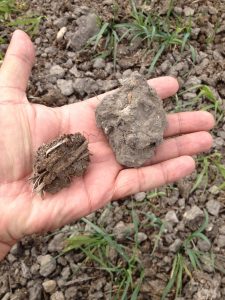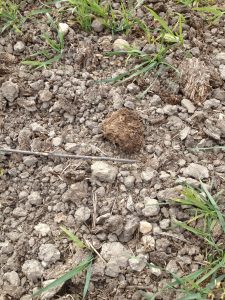Soil Organic Matter and Its Benefits
Soils of Northern Great Plains are relatively young (11000 to 14000 years old) and have some of the highest organic matter levels (4 to 7%) of all mineral soils in the United States (Overstreet and DeJong-Huges, 2009). However, continuous cropping, poor management practices and loss of topsoil have adversely affected the soil organic matter levels.
Soil organic matter is non-uniform in nature and does not have any defined physical or chemical structure. It can be present in soils under various stages of decomposition. Crop and plant residue, tree litter, livestock manure (figure 1), animals and different types of soil organisms, their by-products and to a lesser extent human waste contribute to form organic matter. Active fraction (roots and residue) is the food source of soil microorganisms. Stable fraction (humus), stores carbon and reduces loss of organic carbon to decomposition.
Decomposition Process and Functions
Earthworms, mites and beetles shred organic material into small pieces. Nematodes consume carbonaceous living material such as plants roots, microorganisms and other nematodes. Bacteria and fungi break down and decompose organic matter while feeding on it releasing essential nutrients: nitrogen, phosphorous, potassium, sulfur and others. Microorganisms also release enzymes that increase the rate of decay (Fortuna, 2012). As organisms decompose organic matter, they use carbon as a source of energy and nitrogen to produce protein. On average microorganisms, require 25 to 30 parts of carbon for every part of nitrogen they consume. Therefore, high C:N ratios above 30:1 will result in slower decomposition rates, whereas, low C:N ratios below 20:1 will result in nitrogen losses.

Figure 2. A recently added aggregate of livestock manure (left) versus a heavy soil aggregate of poor structure on the right.
Though small in proportion by weight, organic matter is linked to important functions in the soils and is critical to maximizing biological activity within the soil. Humus along with clay particles provide cation exchange sites in soils, reducing nutrient leaching losses. Microorganism using organic matter as food source promote soil particles aggregation, resulting in improved structure (figure 2), soil water infiltration and holding capacity. It reduces the potential for runoff and erosion as well. Higher organic matter levels also result in favorable soil temperatures, improved plant root growth, healthy microbial populations and moderate pH ranges.
Practices That Can Increase Soil Organic Matter Levels
- Crop rotations by planting;
- Cover crops to provide soil cover to reduce evaporation, erosion and runoff.
- Perennial grasses to add above-the-ground as well as below-the-ground biomass.
- Legumes for green manure purposes.
- Planting crops/plants that produce greater biomass.
- Incorporate straw/crop residues.
- Reduced tillage to minimize soil carbon losses and to slow down organic matter decomposition processes.
- Application of fertilizers on cover crops and legumes to produce more biomass.
- Application of manure, plant material or other carbon-rich waste.
- Using forage by grazing versus harvesting.
For more information, please follow https://www.ag.ndsu.edu/langdonrec/soil-health/soil-organic-matter-and-its-benefits/view.
Author: Naeem Kalwar, North Dakota State University
Reviewer: Rick Koelsch, University of Nebraska – Lincoln
Funding support from North Central Region Water Network.


That is interesting that the loss of topsoil has affected organic matter levels. It would be good to get some topsoil to help that. That is something I would want to do sometime soon.